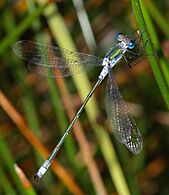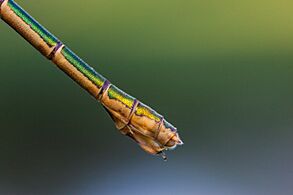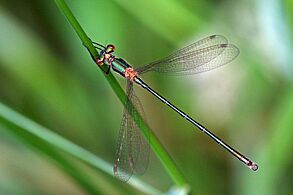Emerald damselfly facts for kids
Quick facts for kids Emerald damselfly |
|
|---|---|
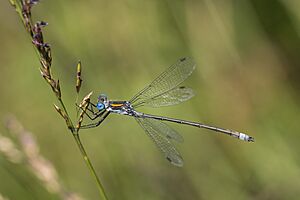 |
|
| Male Warren Heath, Hampshire, England |
|
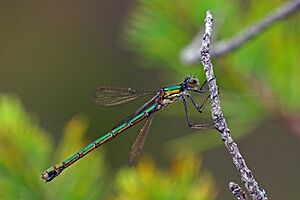 |
|
| Female Coire Loch, Glen Affric, Scotland |
|
| Conservation status | |
| Scientific classification |
The Lestes sponsa is a type of damselfly often called the emerald damselfly or common spreadwing. These insects have a shiny metallic green color and brown spots on their wings. You can usually find them near ponds that have lots of aquatic plants. When they rest, their wings are often held half-open, which is a special way they pose!
Contents
About the Emerald Damselfly
Emerald damselflies are some of the larger damselflies you might see. They are most common during July and August. You'll often spot them near ponds and lakes, but almost never near fast-flowing water. They love to perch among tall reeds, where their green color helps them blend in perfectly.
They don't fly as strongly as some other damselflies, like the common blue or large red damselflies. But you might see them flying on misty or rainy days when other damselflies stay hidden. If you disturb an emerald damselfly, it usually won't fly far, just a few feet to another perch. Their habit of resting with their wings half-open is a key feature of their family, the Lestidae, which is why they are also called "spreadwings." Many hundreds of these damselflies can live together in one area.
Reproduction and Life Cycle
Emerald damselflies mate in a way similar to other dragonflies. They form a "tandem pair" away from the water. Mating can last for about 30 to 60 minutes. After mating, the male and female stay connected for egg-laying.
The female usually lays her eggs in plants that are under the water. She pokes a hole in the plant tissue and places her eggs inside. Sometimes, females lay eggs in plants above the water, in places that will later be covered when the water level rises. The eggs start to grow for a few weeks, then their growth slows down a lot. This slow-growth stage is called diapause, and it helps the eggs survive the winter. The emerald damselfly only has one generation per year.
In the spring, a tiny stage called a "prolarva" hatches from the egg. This stage is very short, often lasting only minutes. The prolarva doesn't have legs and can't eat, but it can wiggle or jump to move. If a prolarva hatches out of water, it will move around until it finds water. Once in water, it quickly changes into the next stage, called a "larva."
The larvae are active hunters and grow quickly. They shed their skin many times as they grow. In damselflies, growth only happens during the larval stages. If conditions are good, the final larval stage can be reached in as little as five weeks. Larvae that live in colder places, where summer is short, grow faster to make up for the limited time. They are also more active and better at finding food, sometimes even eating other larvae.
The adult damselflies come out in July and fly until September. When they first emerge, they are not ready to breed. They need about a week or more, depending on the weather, to become mature enough to lay eggs. In some places, this maturation period can be longer, which helps prevent eggs from hatching too early in the autumn, as those larvae wouldn't survive the winter.
How They Look
All species in the Lestes group look very similar, so it can be tricky to tell them apart in nature. One way to identify them is by looking at the shape of their anal appendages (parts at the end of their body). For the L. sponsa, these appendages are black. The upper ones have two small teeth inside. The lower ones are long and round. In northern Europe, there are five types of Lestes, and in all of Europe, there are six, so it's best to look at many different features to be sure.
The L. sponsa is a typical member of its group. It has a metallic green body and holds its wings away from its body when resting. Its body is about 26 to 33 millimeters (about 1 to 1.3 inches) long, and its wings are about 19 to 23 millimeters (about 0.7 to 0.9 inches) long.
Adult males have a powdery blue color on their front body part (prothorax) and on the first two and last two segments of their abdomen. They also have blue eyes. Females do not have this blue color. Young males also lack the blue color and have greenish-brown eyes. The small, colored spots on the wings of young males (called pterostigmata) are almost white.
Where They Live
Emerald damselflies prefer habitats like pools, ponds, and moorlands. They like still water or water that flows very slowly. This damselfly has a very wide distribution across Europe and Asia, from Spain all the way to the Pacific Ocean.
You won't find them in the far north of Europe and Asia, or in the very south, like southern Spain, southern Italy, or Greece. They might live in some parts of North Africa, but in the Mediterranean region, they are found in higher, mountainous areas. In Great Britain, the emerald damselfly is the only common Lestes species.
See also
- List of damselflies of the world (Lestidae)
- Lestes dryas
- Lestes barbarus
- Lestes virens
- Lestes macrostigma
- Chalcolestes viridis (formerly Lestes viridis)
- Chalcolestes parvidens (formerly Lestes parvidens)



